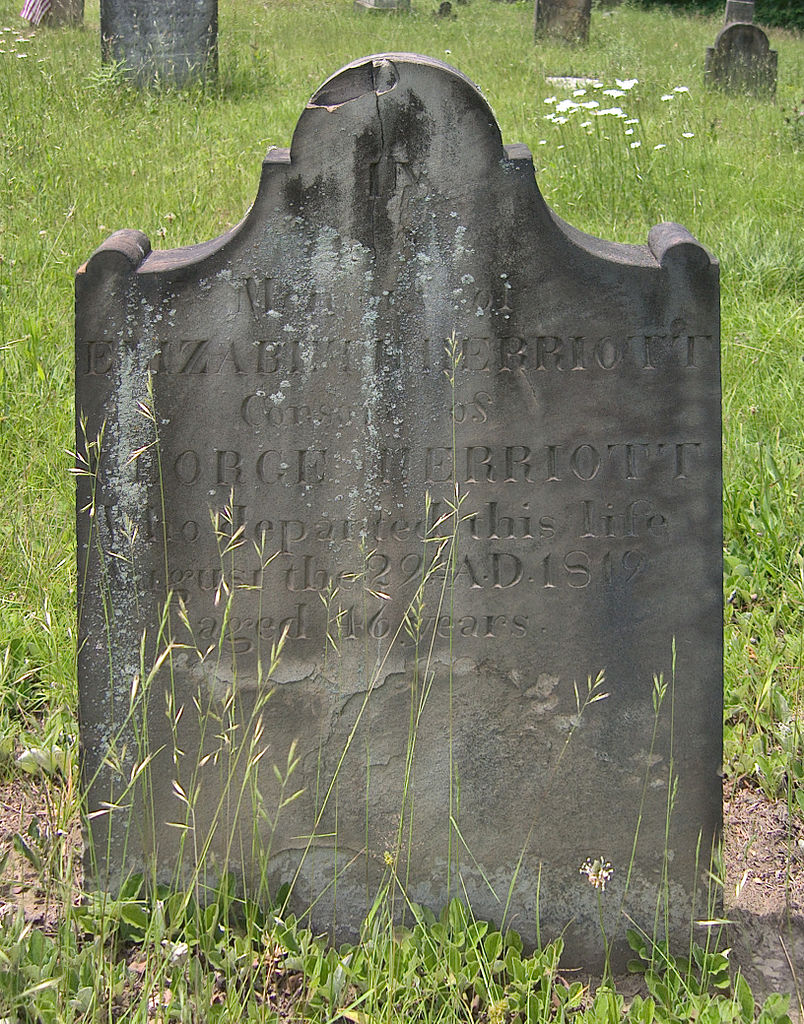Very few of the stonecutters who worked around here before 1840 (or after, for that matter) signed their work. But occasionally one who was particularly proud of one of his productions would put his mark on it, although—oddly—none of them seem to have made a habit of it. J. Sumny, for example, signed this stone:
The signature “J.Sumny sculpture,mingo” is prominent. “Mingo” was a common term for local American Indian tribes; it is probably the name of a settlement—perhaps Mingo Creek, south of Finleyville, where there is still a church whose congregation was heavily involved in the Whiskey Rebellion.
This one of only two stones visibly signed by J. Sumny, but we can identify others by him in the same graveyard.
Elisabeth Law’s is also certainly one of his;
In addition to the fan ornaments in the corners, note the characteristic ornamental dash after the main inscription and the distinctive ordinal (“26th”) with the superscript “th” underlined, and a double comma under the underline. (Distinctive, but not unique: at least one less artistic stonecutter in the same cemetery also used the underline and double comma for abbreviations.)
Though it lacks the ornaments, Elisabeth Jeffery’s stone is also by J. Sumny:
Again we see the characteristic ordinal and ornamental dash, as well as the backslant in the line that identifies the relations of the deceased.
Moses Coulter McDowell’s tombstone shows all the same quirks, though the shape of the stone itself is fashionably Gothic, like most of the rest of J. Sumny’s stones (the Joseph Alexander stone above is damaged, but probably had the same Gothic spikes). Moses was another child taken away by the same scarlet-fever epidemic that killed Elizabeth Jeffery; it must have been a profitably busy time for stonecutters.
Again we see that distinctive way of forming ordinals (and the abbreviation “Janr.”)
Hardly a family in the Bethany Presbyterian Church was spared by this scarlet-fever epidemic. The winter of 1831 was a somber time in the little settlement. Catharine Herriott also died, and was given a very fine stone by J. Sumny:
It is a rare thing to be able to identify one of these local craftsmen by name, but J. Sumny’’s signature on one stone has allowed us to attribute a number of others to the same artist.
Added: J. Sumny continued to practice in this area for some years, and Father Pitt has found another signature of his, this time on a very plain stone. Father Pitt is inclined now to believe that he signed all his works, but almost always near the bottom of the stone, so that most of the signatures are under the ground by now. Indeed, the first time Father Pitt photographed the James Hastings tombstone from 1840, the signature was not visible:
But having fortunately returned just after the cemetery received one of its infrequent mowings, he found the signature that had been obscured by vegetation. We see here that, by 1840, he was spelling his name “Sumney”:
Recognizing that the style of J. Sumny (or Sumney) had changed somewhat over the years, Father Pitt is now inclined to say that probably half the early settlers’ tombstones in this graveyard were inscribed by him.
















